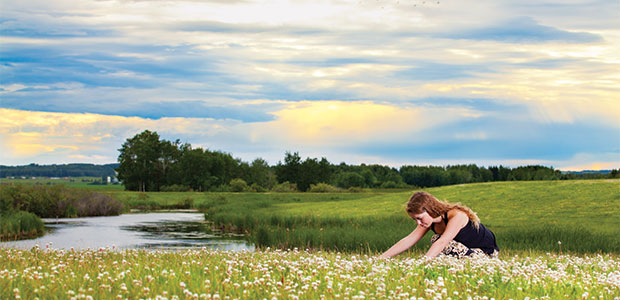
In Yin yoga, poses are held for up to eight minutes. Find out how you can benefit from this passive style of yoga.
Ashtanga, Iyengar, restorative, hot, flow, and power—there are a variety of yoga styles to choose from depending upon your interests and abilities. Each offers opportunities for bodily, emotional, and spiritual strengthening and insight. But Yin yoga stands out with its transformative approach to yoga practice.
What is Yin yoga?
In Yin yoga, postures are passively held from three to eight minutes. This deep holding brings more lengthening, elasticity, and therapeutic release to the connective tissues, ligaments, bones, and joints than more active yoga styles do. It also provides a profoundly meditative opportunity to move past our frantic thoughts and pace, and surrender body and mind.
“Through the long, relaxed holds,” says Angela Jervis-Read, yoga teacher and owner of a yoga studio in Toronto, “we are able to liberate the body’s fascial network and release ingrained holding patterns.” (The fascia is a layer of fibrous tissue that surrounds muscles and blood vessels, binding, supporting, and protecting them.)
Yin and yang
Yin yoga draws upon the classic Chinese philosophical properties of yin and yang. Understanding these can help us achieve greater wellness through balance. By recognizing the yin and yang qualities of our dispositions and ailments, we can balance them with foods, herbs, acupuncture, and activities such as yoga.
Yin and yang are complementary rather than a duality, and each of us is a blend of both. Melissa Carr, DrTCM, says that “yin and yang are mutually supportive forces.” Tuning in to the yin and yang tendencies of our health and temperament can support equilibrium. Carr recommends that we notice “where and when we feel heat or cold, movement or stillness, expending or storing energies.” From there, she encourages us to use yin and yang to shift out of stagnation or overstimulation to find balance.
We can do this by practising Yin yoga. Sometimes called Taoist yoga, Yin yoga is said to be one of the oldest types of Hatha practices. An approach that helps acclimate the body to meditation, Yin yoga was actively reinvigorated in the 1970s and ’80s by yoga teachers Paul Grilley, Paulie Zink, and Sarah Powers. Yin’s popularity continues to grow.
Yins and outs
Yin’s passive poses are done on the floor. The stillness and relaxation of Yin postures help the body become more flexible, enhance circulation, and clear energy blockages. While active yoga styles call upon strength and stamina, Yin targets areas of the body seldom tended to.
“Connective tissue does not respond to quick movements or short holds,” explains senior yoga teacher Angie Ackerman. “Like a piece of toffee that you want to share, it requires patience and a slow steady pull.”
“By manipulating the network that surrounds our skeletal frame, organs, muscles, and other systems of the body, we create space. Stagnation is a breeding ground for disease. By opening up our channels we allow the body room to do its work,” says Jervis-Read.
A Yin class often consists of twists, hip openers, and forward bends. Ackerman explains that Yin poses target the connective tissues of the pelvis downward and that “the lower half of the body is yin, the upper half is yang.” Postures, named differently in Yin, may resemble those of yang yoga classes, but come with important differences, namely foot placement, spinal rounding, or bent knees.
Yinsight
With fewer postures held for longer, Yin is intensely meditative. Yin yogis work toward “supple bodies, flexible minds, and deepened tolerance and patience,” shares Jervis-Read. Yin invites us to be present through discomfort, accept aches as they come and go, and resist constant shifting. We are also urged to gently recognize but not indulge the presence of distraction, self-doubt, and mental list making. It may look as if you aren’t doing much, but intense activity is going on inside the body.
Practice tips
Yin is best suited to, and most benefits, those with an already established yang practice. If you are immersed in an active, muscular style of yoga, known as yang, Yin can be a healthy addition to your practice. Ackerman says that since“Yin does not teach you how to breathe, stretch, or strengthen the muscles, Yin is a complement, not a replacement [for yang practice].” It is not recommended for beginner yoga students.
Ideally, Yin should be practised with a teacher. It can be of indispensable support to practise with an adept teacher who can offer modifications and help through the meditation of long holds.
It’s also a good idea for pregnant women, seniors with brittle bones, and those with a history of physical or emotional trauma to check with a health care practitioner and a skilled teacher before beginning a Yin practice.
As with any form of yoga or movement, overdoing it is always possible, so it’s crucial to listen to your body carefully, particularly for indications of strain, pain, panic, or unease.
Jervis-Read describes how in a Yin class “we are on our edge, exploring our perceived limitations.” Likewise, Ackerman holds that Yin “is the ultimate form of meditation, transformational, emotionally and energetically.” Yin takes us to the depths, in body, mind and soul. a
The 3 principles of Yin practice
- Softness: Muscles should be cool and relaxed.
- Stillness: Practise without moving, adjusting, or fidgeting.
- Steadiness: Remain in the posture for approximately three to eight minutes; follow the guidance of your yoga teacher.
Yin and yang
Yin and yang are two facets of existence that complement each other. This concept has existed since Confucian times in ancient China when the middle point was called the Dao. Outside of this centre are yin and yang. When yin and yang are equal, the body is in a state of wholeness and health.
| Yin | Yang |
|
|




































